Trauma: Thoracic Vascular Trauma
Thoracic Vascular Injury
AAST Thoracic Vascular Injury Scale
- *See AAST
- Injury Scale is Under Copyright
Basics
- Thoracic Vascular Injury Causes 50% of All Trauma Deaths
- Most Common Large Vessel Injury:
- Stab Wound: Ascending Aorta
- GSW: Descending Aorta
- Blunt: Aortic Isthmus (Just Beyond Left Subclavian Takeoff)
- Postoperative Paraplegia Incidence:
- Open Surgery: 8%
- Endovascular: 1%
Blunt Aortic Injury (BAI)
- Vancouver Classification:
- Grade I: Intimal Flap, Thrombus or Intramural Hematoma < 1 cm
- Grade II: Intimal Flap, Thrombus or Intramural Hematoma ≥ 1 cm
- Grade III: Pseudoaneurysm without Contrast Extravasation
- Grade IV: Free Rupture with Contrast Extravasation
- Thoracic Aorta Transection
- Cause: Rapid Deceleration
- Highest Risk Sign: 1st/2nd Rib Fracture
- Most Common Site: Ligamentum Arteriosum
- Dx: CXR, Then CTA (If Stable)
- Tx:
- Grade I: Anti-Impulse Control
- Goal SBP ≤ 100 mmHg
- Goal HR ≤ 100
- Grade II-IV: Repair
- Stable:
- Ascending or Arch: Open Repair
- Descending: TEVAR (Thoracic Endovascular Aortic Repair)
- Vs Open Repair – Lower Mortality, Blood Loss & Paraplegia Risk
- May Require Coverage of Left Subclavian Depending on Location
- Unstable: Open Repair
- Stable:
- Grade I: Anti-Impulse Control
CXR Findings Suggestive of Vascular Injury
- Indistinct Aortic Knob
- Wide Mediastinum > 8 cm
- Left Main Bronchus Depression > 140 Degrees
- Deviation of NG/ET Tubes to the Right
- Massive Hemothorax
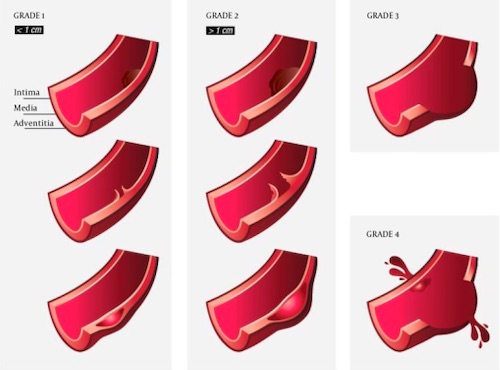
Vancouver Classification of BAI 1
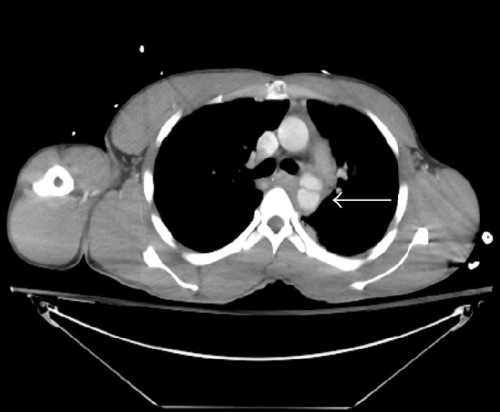
Aortic Pseudoaneurysm 2
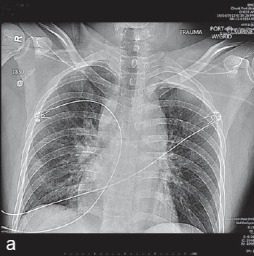
BAI CXR (Indistinct Aortic Knob & Widened Mediastinum) 3
Injury Management
- Great Vessels:
- Endovascular vs Surgical Repair (Primary Repair or Bypass-Exclusion with Graft)
- Consider Subclavian Ligation in Damage Control
- Vertebral Artery Access:
- Segment V1 (Pre-Foraminal) – Subclavian Incision
- Segments V2-4 – Require Neurosurgery or Endovascular Repair
- Azygous Vein: Primary Repair vs Ligation
- Internal Mammary Artery: Ligation
- Thoracic Duct: Ligation
Great Vessel Arterial Exposure
Bullet Embolism
- Large Diameter of Thoracic Vessels Enables Bullets to Lodge & Migrate Distally
- Most Commonly Lodge in Iliac or Femoral Arteries
- Tx: First Control Thoracic Bleeding Then Bullet Embolectomy
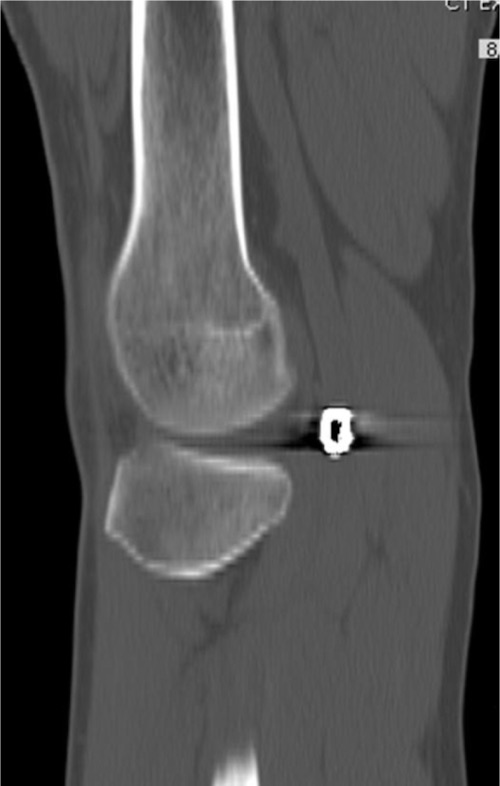
Bullet Embolism CT 5
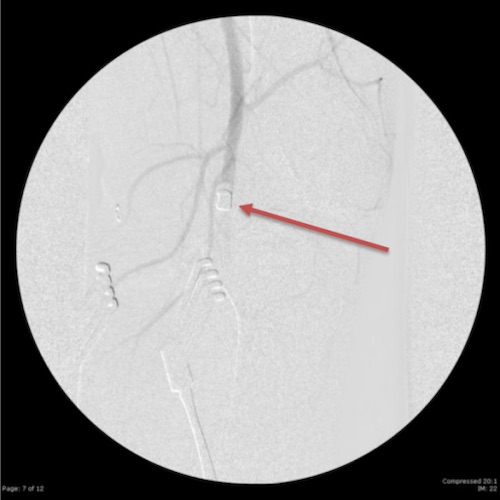
Bullet Embolism Angio 5
References
- Forcillo J, Philie M, Ojanguren A, Le Guillan S, Verdant A, Demers P, Lamarche Y. Outcomes of Traumatic Aortic Injury in a Primary Open Surgical Approach Paradigm. Trauma Mon. 2015 May;20(2):e18198. (License: CC BY-NC-4.0)
- Chen C, Schuster K, Bhattacharya B. Motor vehicle collision patient with simultaneous duodenal transection and thoracic aorta injury: a case report and review of the literature. Case Rep Surg. 2015;2015:519836. (License: CC BY-3.0)
- Alameddine AK, Alimov VK, Alvarez C, Rousou JA. Unexpected traumatic rupture of left atrium mimicking aortic rupture. J Emerg Trauma Shock. 2014 Oct;7(4):310-2. (License: CC BY-NC-SA-3.0)
- Anatomography. (License: CC BY-SA-2.1 JP)
- Huang J, Pandey V, Shah R, Yedavalli V, Joshi A, Stimpson R, Keldahl M, Zuiderveld L. Popliteal artery embolism of bullet after abdominal gunshot wound. Radiol Case Rep. 2016 Nov 2;11(4):282-286. (License: CC BY-NC-ND-4.0)